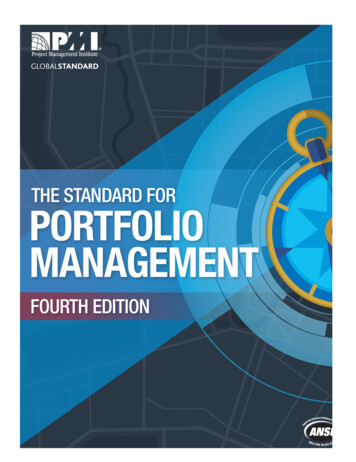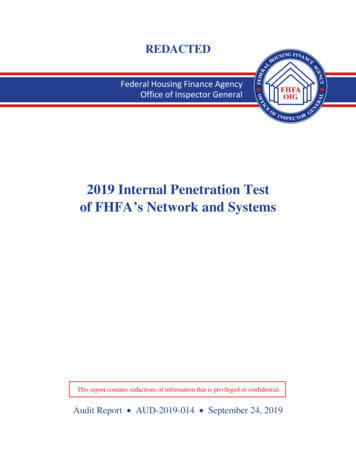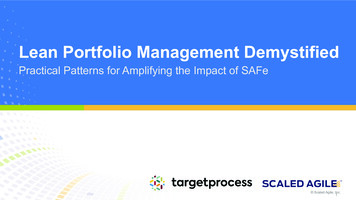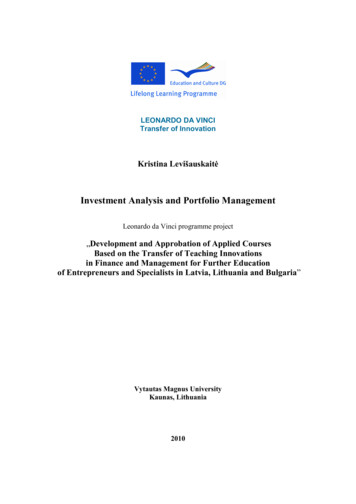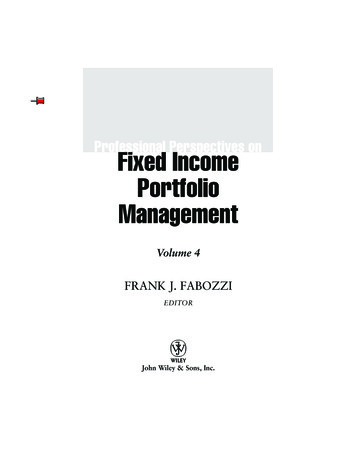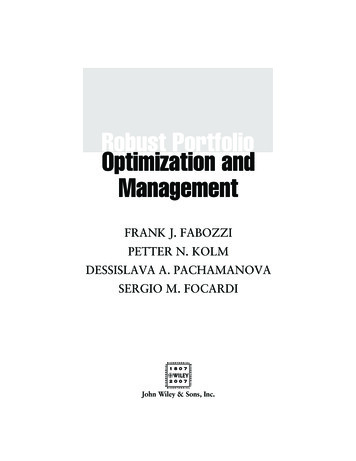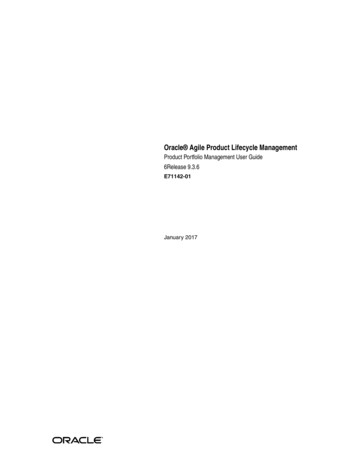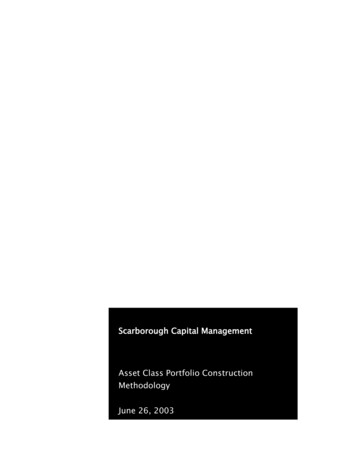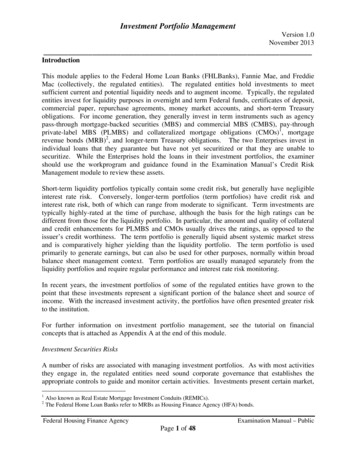
Transcription
Investment Portfolio ManagementVersion 1.0November 2013IntroductionThis module applies to the Federal Home Loan Banks (FHLBanks), Fannie Mae, and FreddieMac (collectively, the regulated entities). The regulated entities hold investments to meetsufficient current and potential liquidity needs and to augment income. Typically, the regulatedentities invest for liquidity purposes in overnight and term Federal funds, certificates of deposit,commercial paper, repurchase agreements, money market accounts, and short-term Treasuryobligations. For income generation, they generally invest in term instruments such as agencypass-through mortgage-backed securities (MBS) and commercial MBS (CMBS), pay-throughprivate-label MBS (PLMBS) and collateralized mortgage obligations (CMOs)1, mortgagerevenue bonds (MRB)2, and longer-term Treasury obligations. The two Enterprises invest inindividual loans that they guarantee but have not yet securitized or that they are unable tosecuritize. While the Enterprises hold the loans in their investment portfolios, the examinershould use the workprogram and guidance found in the Examination Manual’s Credit RiskManagement module to review these assets.Short-term liquidity portfolios typically contain some credit risk, but generally have negligibleinterest rate risk. Conversely, longer-term portfolios (term portfolios) have credit risk andinterest rate risk, both of which can range from moderate to significant. Term investments aretypically highly-rated at the time of purchase, although the basis for the high ratings can bedifferent from those for the liquidity portfolio. In particular, the amount and quality of collateraland credit enhancements for PLMBS and CMOs usually drives the ratings, as opposed to theissuer’s credit worthiness. The term portfolio is generally liquid absent systemic market stressand is comparatively higher yielding than the liquidity portfolio. The term portfolio is usedprimarily to generate earnings, but can also be used for other purposes, normally within broadbalance sheet management context. Term portfolios are usually managed separately from theliquidity portfolios and require regular performance and interest rate risk monitoring.In recent years, the investment portfolios of some of the regulated entities have grown to thepoint that these investments represent a significant portion of the balance sheet and source ofincome. With the increased investment activity, the portfolios have often presented greater riskto the institution.For further information on investment portfolio management, see the tutorial on financialconcepts that is attached as Appendix A at the end of this module.Investment Securities RisksA number of risks are associated with managing investment portfolios. As with most activitiesthey engage in, the regulated entities need sound corporate governance that establishes theappropriate controls to guide and monitor certain activities. Investments present certain market,12Also known as Real Estate Mortgage Investment Conduits (REMICs).The Federal Home Loan Banks refer to MRBs as Housing Finance Agency (HFA) bonds.Federal Housing Finance AgencyExamination Manual – PublicPage 1 of 48
Investment Portfolio ManagementVersion 1.0November 2013credit, operational and country risks to an organization and will affect the regulated entity’soverall financial condition and performance. A discussion of the primary risks associated withinvestment securities and money market assets follows.1) Corporate Governance (Board and Senior Management Oversight)The board of directors and senior management are ultimately responsible for the regulatedentity’s investment activities. Risk management standards for investment portfolio managementshould be developed and included in policies and procedures. The board and senior managementhave the responsibility to fully understand the risks involved in the investment managementpractices and the potential exposure to loss resulting from investment activities. The board andmanagement should determine the tolerance for risk and should ensure risks from investmentactivities are consistent with the institution’s mission, and are effectively measured, monitored,and controlled. The board and management must ensure appropriate, regular reporting is inplace to monitor potential risks to the institution.Some of the more common weaknesses in a regulated entity’s failure to establish a system ofsound corporate governance include:a) Key risks and controls are not adequately identified, measured, monitored, andcontrolled.b) The regulated entity has not implemented a sound risk management frameworkcomposed of policies and procedures, risk measurement and reporting systems, andindependent oversight and control processes.c) Management has not sufficiently analyzed new products or activities, taking into accountpricing, processing, accounting, legal, risk measurement, audit, and technology.d) Risk management, monitoring, and control functions are not independent of the positiontaking functions.e) Duties, responsibilities, and staff expertise, including segregation of operational andcontrol functions, are not adequately defined.f) Independent audit coverage and testing is limited; auditors are inexperienced or lack thetechnical expertise to test the control environment.2) Market RiskThe investment term portfolio, which often contains longer-term, fixed-rate assets, is usually asignificant source of interest rate risk.3 From an interest rate risk standpoint, “price sensitivity”refers to how much a security’s price fluctuates when interest rates change. Regardless of thesecurity type, a security’s price sensitivity is primarily a function of the following:a) Maturity;3Fannie Mae and Freddie Mac use the term “retained portfolio” when referring to the investment portfolio.Federal Housing Finance AgencyExamination Manual – PublicPage 2 of 48
Investment Portfolio ManagementVersion 1.0November 2013b) Option features;c) Coupon rate; andd) Yield level.A discussion of how each of these security’s price sensitivity functions influences the interestrate risk exposure of a regulated entity follows.MaturityFor securities, maturity is an important price sensitivity determinant. A long-term security’sprice will change more than the price of a short-term security under a parallel change in interestrates.Example: If interest rates rise 100 basis points, a 30-year, 5 percent coupon Treasury bond wouldlose nearly 14 percent of its value, while a two-year, 5 percent coupon Treasury note would loseless than 2 percent.Option FeaturesOptions can either increase or decrease a security’s potential for price changes, depending uponthe option type and who owns it. A call option allows the security’s issuer to redeem the fullamount of the obligation before its maturity date. When a callable bond is purchased, forexample, the investor has sold, or is “short,” the option, which means the issuer can call the bondprior to maturity according to the contractual terms. In exchange for selling this option, theinvestor receives a higher yield. A callable security’s price sensitivity will behave differentlydepending upon whether it is a non-amortizing or amortizing security.A put option allows the investor to return the bond at par value to the issuer prior to its statedmaturity. Here, the investor owns the option and will exercise this right when interest rates haverisen, since they can reinvest the proceeds at higher market yields. The put option thus limitsprice declines when rates rise, because the investor can redeem the bond at par on a specifieddate. When interest rates fall, however, the security’s price will rise like an option-less bond. Aput bond’s asymmetry gives it an attractive risk-return profile, which is why investors will acceptlower yields.Non-Amortizing SecuritiesNon-amortizing securities, which are also referred as “bullet” securities, have only one principalpayment. That payment sometimes occurs before maturity and it could even exceed par value ifit has a call premium. For example, a security could be callable at a dollar price of 102 percentof its par value.Federal Housing Finance AgencyExamination Manual – PublicPage 3 of 48
Investment Portfolio ManagementVersion 1.0November 2013The call option on non-amortizing securities limits price increases when rates fall becauseinvestors are not willing to pay large premiums if the issuer can redeem the bonds prior tomaturity. The three most common types of call options are listed below.a) An American call option allows the issuer to call a security at any time prior to theexpiration date.b) A European call option only permits the issuer to call the security on the option’sexpiration date.c) A Bermudan call allows the issuer to call the security at predetermined intervals over thesecurity’s life.Example: The issuer of a five-year bond with a Bermudan call option could allow the issuer tocall the bond in two years or on any coupon payment date thereafter. This type of bond is oftenreferred to as a “five non-call two.” Every possible call date will have a direct bearing on thesecurity’s price sensitivity.If interest rates rise, a non-amortizing callable bond’s price sensitivity will ultimately approachthe same sensitivity of non-callable securities with an identical maturity. For instance, thepreviously described “five non-call two” bond will initially have the price sensitivity of a twoyear non-callable bond. However, if interest rates rise, the bond would eventually depreciate likea non-callable five-year security. Therefore, callable securities can lose value at an increasingrate as the security’s effective maturity becomes longer.Amortizing SecuritiesAmortizing securities, such as MBS, have some of the non-amortizing securities’ performancecharacteristics. In the case of MBS, the mortgage lender for the MBS’s underlying loans sells acall option to the borrower since the borrower has the right to prepay the loan, in essence callingthe debt. Likewise, a mortgage security investor has essentially sold a call option to themortgage borrower since the investor is relying upon the continuation of the underlying loan’scash flow. Homeowners have an economic incentive to exercise the call option when interestrates fall because they can refinance at lower interest rates. The borrower’s prepayment optionlimits a mortgage security’s price appreciation when interest rates fall.When interest rates rise, amortizing securities may also lose value at an increasing rate, as theiraverage lives extend. Average life refers to the average length of time a dollar of principalremains outstanding. For example, a mortgage security could have an estimated average life offive years. However, as rates go up, the average life could extend to seven years because fewerhomeowners would have an incentive to prepay and thus, its price sensitivity would becomesimilar to a seven-year security, rather than a five-year security.Federal Housing Finance AgencyExamination Manual – PublicPage 4 of 48
Investment Portfolio ManagementVersion 1.0November 2013Amortizing securities can be pass-through4 or structured securities. In a pass-through security,investors get their pro rata share of principal and interest payments. If an investor owns onepercent of the security’s par value, the investor will receive one percent of the cash flow. Theunderlying mortgages’ cash flow “passes through” to investors. In a structured security,investors share the cash flows on a prioritized basis by purchasing into a “tranche” or class. Thesecurity’s prospectus details when the investor will receive interest, principal, and/orprepayments.Structured securities like CMOs often have very complex structures and can lose value at asignificantly increasing rate. When rates change, a security can be structured so that sometranches could have limited cash flow variability and other tranches could have substantial cashflow uncertainty.Example: A higher-risk CMO tranche could have an average life that changes from 2 years to 20years with a 200 basis point increase in interest rates. In this example, higher-risk refers to thetranche’s cash flow variability, not its credit quality, although underwriters can create structuredsecurities that combine higher average life sensitivity with lower credit quality.The highest yields go to those tranches that, by design, exhibit the most volatile average lives.Such tranches absorb the prepayment risk from the other tranches by receiving excess principalcash when prepayments rise. When prepayments are slower, these tranches may not receiveprincipal cash flow at all in order to protect or support the CMO’s other tranches. The protectedtranches could even have lower risk than a pass-through security. Although there are partial callsin the underlying mortgages, some tranche’s payment prioritization rules can result in a completecall of the tranche as rates fall, making it similar to a non-amortizing security.As is illustrated in the above examples, the risk-return profile of callable (non-amortizing) andprepayable (amortizing) securities is not symmetrical. Investors in these securities have limitedupside price potential and are therefore unwilling to pay large premiums for callable assets.Investors use the term “price compression” to refer to these securities’ inability to trade at pricessignificantly above par. However, these securities can have significant downside price potentialwhen rates increase. To compensate investors for these asymmetric and unfavorable riskprofiles, callable and prepayable securities must offer higher yields. The following tablesummarizes callable and prepayable securities:4Sometimes referred to as a pay-through security.Federal Housing Finance AgencyExamination Manual – PublicPage 5 of 48
Investment Portfolio ManagementVersion 1.0November 2013TypeCallableCash Flow PriorityNot iate at an increasing ratewhen interest rates rise as effectivematurity lengthens.Amortizing: pass-through Pro-rata. Examples: Ginnie Limitedpriceupside;canMae, Fannie Mae & Freddie depreciate at an increasing rate asMac MBS.effective maturity lengthens.Amortizing: structuredDetermined by payment rules. Depends upon security structure.Examples: CMO tranches.Some tranches can have very highprice and cash flow risk and othersvery low price and cash flow risk.Coupon RateThere is an inverse relationship between a security’s coupon and price sensitivity. Securitiespurchased at a discount have more price sensitivity than securities purchased at a premium. Adiscount security has a coupon lower than the required market yield and will be priced below parvalue. A premium security has a coupon that exceeds the required market yield and will bepriced above par value. The most discounted of all securities is a zero-coupon bond, which ispriced at a discount and redeemed for par value at maturity. Its only cash flow is the return ofpar value at maturity. For any given maturity, a zero-coupon bond will have the most pricesensitivity.The inverse relationship between coupon rate and price sensitivity results from the cash flowdistribution. A high-coupon security’s cash flows will include more interest paymentsthroughout the security’s life than a lower coupon bond. Therefore, a higher-coupon bond willhave a higher proportion of its cash flow returned sooner than a lower coupon bond. Securitieswith earlier cash flow will have less price sensitivity. A zero coupon bond will have the mostprice sensitivity of bonds with the same maturity because its only cash flow is the par valuereceived at maturity.Yield LevelNon-callable bonds have more price sensitivity when market yields are low as opposed to whenmarket yields are high, because of the curved or “convex” nature of the relationship betweenprice and yield.5 This relationship means that non-callable bonds rise in value at an increasingrate when interest rates fall and their value declines at a decreasing rate when interest rates rise.5Refer to the Interest Rate Risk Management module for information pertaining to convexity.Federal Housing Finance AgencyExamination Manual – PublicPage 6 of 48
Investment Portfolio ManagementVersion 1.0November 2013The following table summarizes the above price sensitivity factors:FactorMaturityOptionsCouponYield LevelsHigher SensitivityLong maturitiesSold calls: limited upside pricegains; full downside price exposureLower couponsLow yieldsLower SensitivityShort maturitiesPurchased puts: limited downsideprice losses; full upside price potentialHigher couponsHigh yieldsFloating-Rate SecuritiesInvestors often mistakenly assume that floating-rate securities have little price sensitivity risk,although there are features that can cause them to have higher price sensitivity includingembedded options, long maturities, and credit risk.Example: Consider a security that has a LIBOR plus 50 basis points coupon with a 7 percent cap.The cap prevents the coupon rate from exceeding 7 percent, even when LIBOR exceeds 6.50percent.The longer cash flows remain outstanding on floating-rate securities, the greater their potentialprice decline, since the investor faces a lengthier period of having the coupon capped at a belowmarket rate. If a floating rate CMO’s average life increases from 3 years to 15 years when ratesrise, reducing prepayments, the investment’s value is likely to fall sharply. This explains whyCMO floaters with high average life variability offer greater spreads over LIBOR than floaterswith lower average life variability. Adjustable-rate mortgage securities generally have bothperiodic and lifetime caps and floors.Floating-rate assets can also have high price sensitivity without caps.Example: An investment with a LIBOR plus 50 basis points coupon, issued at a time wheninvestors demanded 50 basis points over LIBOR. The security will be issued at par, but if atsome future date investors demand a 150 basis point spread over LIBOR, then the security’sspread is 100 basis points “below the market” and will trade at a discount. This 100 basis pointsloss would be comparable to a fixed-rate security yielding 5 percent when the market demands a6 percent yield.The longer a security’s maturity, the more depreciation it will have.A more complex type of floater is an inverse floating-rate security, which has a coupon thatincreases when market rates decrease.Example: An inverse floater could have a coupon of 8 percent minus three-month LIBOR.Investors typically purchase these securities when the yield curve is very steep, as the couponFederal Housing Finance AgencyExamination Manual – PublicPage 7 of 48
Investment Portfolio ManagementVersion 1.0November 2013formula often creates a rate well above short-term financing rates.increases, the coupon could drop very low and possibly to zero.However, if LIBORAs inverse floaters could lose significant value depending on the coupon formula, regulatedentities should exercise caution with such securities.Some floating-rate securities have traded with prices well below par value, even without creditproblems due to structural risks such as interest rate caps and highly variable cash flows.Regulated entities should therefore fully understand the price sensitivity imposed by thesecurity’s structure, maturity, option features, and credit risk.Portfolio Sensitivity Limits and MeasurementThe investment portfolio typically has a significant effect on a regulated entity’s overall interestrate risk profile. Therefore, the regulated entity should consider instituting investment relatedsensitivity limits. For example, the regulated entity could establish limits as a percent of capitalor earnings. For further interest rate risk management details, refer to the examination moduleon Interest Rate Risk Management.The presence of a few securities with high risk may, or may not, be a supervisory concern.Whether a security is an
Management module to review these assets. Short-term liquidity portfolios typically contain some credit risk, but generally have negligible interest rate risk. Conversely, longer-term portfolios (term portfolios) have credit risk and inter
